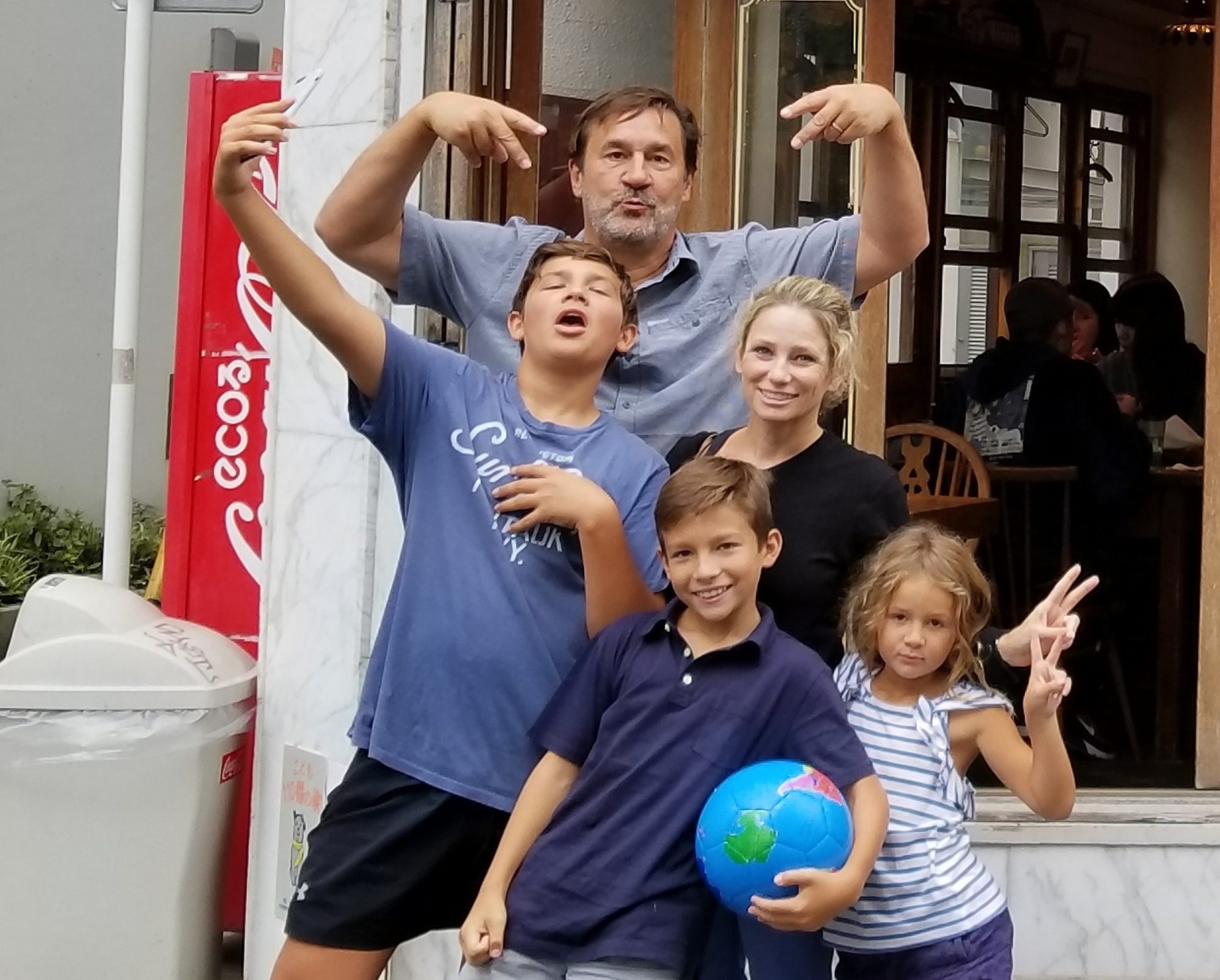

Kyoto Monkey Park Hike Brochure by Annika
Yesterday we hiked up a hill in Kyoto. On top of the hill was a monkey park. Here is my brochure of the rules.

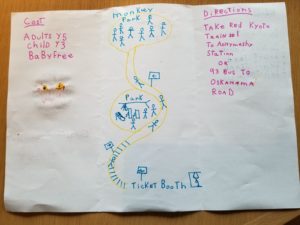
Writing Brevity. Read. Excellent.
A Day of Sumo by Nicholas
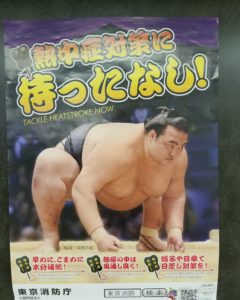
One of the coolest things we wanted to experience in Japan was the famous Sumo wrestling. Tickets were expensive and very hard to get yet my dad was determined to experience Sumo. We finally got tickets for Tuesday, September 19th. My dad wanted to see the ceremonies (we had no idea what those were either) which started at 14:20. Naturally, we arrived at 13:00, leaving us an hour and twenty minutes to check the place out until the ceremony started.
The first rule of Sumo, we can talk about Sumo.
When we walked into the stadium, we faced a huge room with a wall of people on the other side. We showed our tickets to the lady working at the stadium and asked her if she could tell us where our seats were located. In Japan, most people don’t speak English, but we were in luck. We were on the second floor, row 6, seats 3-8. I didn’t realize at first that there were only two floors. In comparison to a soccer or football stadium, this was tiny, holding a little over 10,000 people. The bottom floor had rows and rows of pillows that people would sit on to watch the matches. Hours seated in the small folded position with legs crossed! The second floor had fixed velvet chairs in which we sat, and all of the restaurants were on that level. Only people seated in these sections with chairs could watch and eat. Strangely, the chairs had beer bottle openers attached with string to each little table. We remarked that in America, those would be gone in minutes. No one steals anything in Japan.
 Next, we went looking for was food. In Sumo, chicken is a symbol of good luck because chickens stand on two legs and wrestlers need to stay on their feet to win. There were bento boxes, chicken skewers, and a sit-down restaurant. I love chicken, so I got the chicken skewers with fries. It tasted way better than I expected. We were allowed to take our food to our chair seats, so we could eat while Sumo matches took place.
Next, we went looking for was food. In Sumo, chicken is a symbol of good luck because chickens stand on two legs and wrestlers need to stay on their feet to win. There were bento boxes, chicken skewers, and a sit-down restaurant. I love chicken, so I got the chicken skewers with fries. It tasted way better than I expected. We were allowed to take our food to our chair seats, so we could eat while Sumo matches took place.
In the Japanese sport of Sumo Wrestling, over 600 fighters called Rikishi strive to become the Yokozuna. The Yokozuna is the highest and most prestigious rank for Rikishi. In order to achieve this goal, the Rikishi must win many battles called bouts. In order to be eligible to become a Rikishi, you must weigh a minimum of 100kg and endure rigorous training. Bouts are held in a Sumo stadium. In the center of the stadium, there is a 4.55m wide circle made out of rice and straw. The floor is clay with two white lines in the middle indicating where the Rikishi begin the match. Around the circle is a square made of the same materials.
While the bouts usually last no more than 10 seconds, the preliminary rituals are quite intricate. First, the Rikishi step into the fight circle, then walk to one of the corners of the square. In the corner, there is a box containing a lot of salt. The Rikishi scoop up the salt with their hands and throw it into the circle. This is to rid them of bad spirits. They then return to the circle. They stand approximately 2 feet away from their white line. They lift their legs and slap their thighs then return to their regular position. They then bend down and rest their fists on the floor. Once both Rikishi has their fists on the floor the bout begins.
During a bout, 2 Rikishi fight to either knock their opponent out of the circle or cause any part of their body to touch the floor, other than the soles of their feet. The typical duration of a match is only 5-10 seconds, whereas the rituals leading up might be 3 to 4 minutes. Sumo wrestlers propel themselves forward towards their enemy and collide with 4,000 pounds of force. They fight using their own distinct moves until there is one victor. When a Rikishi has won, the referee designates the winner by pointing his war flag to the side from where the winner began. Once the match is over, Rikishi bow to each other and leave the arena. Interestingly, the referee also wears knives on his waist. Those knives are now symbolic, but long ago were used by the referee to commit suicide in the ring if he made a bad call or decision in the match, apparently out of shame!
Most of the time the Japanese people watching were quiet except for the occasional “ooh” or “ah.” When the matches become very close the crowd could become quite boisterous, a huge contrast to the Japanese people’s typical calm demeanor. During the crescendo of the final matches, the crowd was yelling and shouting. When the last match ended, the people sitting on pillows nearest the ring began to throw them into the ring in disgust. We learned the crowd did this because the underdog had defeated the favorite.
Since we really knew nothing about it, Annika, Ali and I voted before each match as to who would win, as a way to keep us interested. Over 4 hours, there are a LOT of bouts. (The day actually begins at 8:00 am and ends at 18:00 pm) At first, I was more interested in the preparatory rituals, than the actual matches. There was always a quick winner and the matches rarely went on for more than 5 seconds. Then we got to the big ceremony, when all the senior level Rikishi walking out, forming a circle, and then the circle of Rikishi then walking off. This was interesting to see. But what really became interesting were the bouts that followed. These were much more exciting as they were using tricks during the rituals to psyche out their opponent. The matches were also much closer, and sometimes even took more than 30 seconds. There were about ten matches until another ritual ceremony. After this second ceremony, we got into big dude territory. You could almost feel the collision from hundreds of feet away. The crowd also got much more involved. These matches were really fun and exciting, making the whole day worth it!

All in all, we really enjoyed watching 300 to 600-pound people slam into each other. Next time, I would go later in the day and only watch the last 30 matches. While the ceremonies are interesting and eating the famous chicken skewers while watching sumo is amazing, I think arriving later and having the big matches be the primary focus might make the experience more enjoyable. I think that my overall sumo experience was quite enjoyable, and I would likely go again.
more links:
http://web-japan.org/kidsweb/virtual/sumo/sumo03.html
https://listverse.com/2014/12/18/10-fascinating-facts-about-sumo-wrestling/https://www.insidejapantours.com/blog/2014/09/16/11-amazing-things-you-probably-never-knew-about-sumo-wrestling/
11 Amazing things you probably never knew about sumo wrestling
Sunday Session I, Kyoto, Japan, and the question of culture
What do we do all day?
We have been fascinated by the stark contrast in the culture between Japan, France, and any other place we have ever lived or visited. As a group, we’ve constructed a long list of quirks, rituals, oddities and cultural differences since our arrival, from the obvious to the subtle. (More on that later from the kidoos)
Here is the starting point for this section, which will overlay our entire journey.
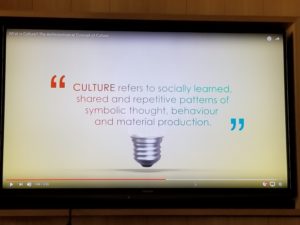

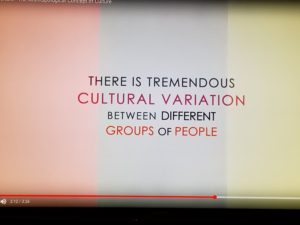
The teacher constructed a large matrix of categories of culture, in which the kids observe and categorize their findings.
This will provide the framework for comparing and contrasting the variation across the destinations we inhabit. From food, religion, music, manners…the list is daunting. And fun.
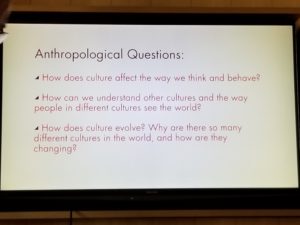

The object is to photograph, or video, or write about, or speak to these differences, and ask why?And how? And what they mean.
And importantly, what’s the best parts…perhaps the shortcomings…the meanings…and how they themselves relate to other cultures. How might others observe us? Finally, how do each of us fit in, and relate to one another in the larger context of this world, seemingly so big…yet so small?
Let me finish by noting, like as not, the kids and we adults are acutely aware of the fact that we wear the “Trump banner.” Interesting times and questions arise from everywhere we go.
Sunglasses help.
Sunday session II, Calligraphy, and the Kyoto crafts museum…
…as it relates to the favorite speech I’ve ever had the pleasure of watching.
“Again, you can’t connect the dots looking forward; you can only connect them looking backward. So you have to trust that the dots will somehow connect in your future. You have to trust in something – your gut, destiny, life, karma, whatever. This approach has never let me down, and it has made all the difference in my life.”
Steve Jobs
Co Founder Apple Inc.
Alexander, the philosopher scientist, “Ya know, at the end of this year the world is going to look pretty small. On second thought, it’s already starting to look really small.”
– Then your task will be to use that perspective to do something good for the world
Walking in Imperial Park, passing a guy wearing a Jets shirts, we remarked, “Wow, a Jets fan in Kyoto.”
Guy: “Given how they play, it’s shocking there’s one anywhere in the world.”
“…dude, you just made the blog.”
Unpacking our baggage, the 5 week mark
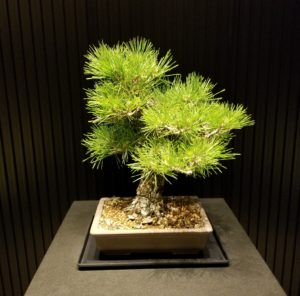
5 weeks, Los Angeles, Soori Bali, Ubud Bali, Flora Sea, Komodo, Singapore, Tokyo.
Off to Kyoto, Hiroshima, Kanazawa, Hakone, back to Tokyo, and then off to Hong Kong.
Exhausting. Exhilarating. And everything we could have hoped for.
Biggest upside surprises: Adaptation to everything. Foods, long hours, unpredictable schedules, cultural stimulation, and the genuine seamless interaction between Professor Gugick and the children.
Biggest downside surprises: Proximity. Being in close confines 24 x 7, difficulty in finding soccer fields and the ceaseless challenges that need be navigated by our rock star leader, Stacia. We salute you daily.
Culturally, Japan is simply other worldly. More on that later from the kids, in their own voices. Be it Sumo, food, cleanliness, respect, rituals, language, simplicity, and a seeming never ending parade of oddities, Japan is crazy cool.
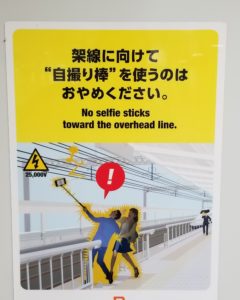

Thus far, it seems that the teacher and student interface is completely natural. We can walk in the door and say, “school in 4 minutes”, and they jump and go (really). They genuinely like it. A lot. Frankly the only disruption is when dad sticks his nose under the tent to see what’s happening. But the truth is, Professor Arthur commands their respect, is engaged on a level beyond that for which we hoped, and the kids adore him. Thank GOODNESS!
Another surprise as relatively easy part has been the near daily transitions from “classroom” to “activities.” Regular “school” runs daily, from 8:30-9:00, until 13:00, 14:00 or 16:00, depending upon availability of actionable “outside” experiences. And boy has each stop delivered experiences, from the mundane to the fascinating. Even just riding subways can be a a new experience.
Next stop , KYOTO, the former capital and cultural center of old Japan for centuries. Bullet train. We are all looking forward to this one.
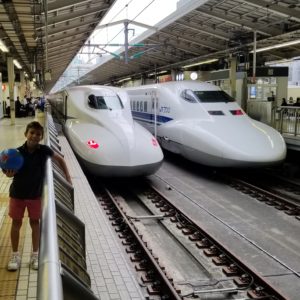
Speaking of which, prior to any activity, we research the upcoming locale, read about and watch videos about the subject matter. Contextualizing as best we can in advance has provided perspective, made the visits relevant, has (nearly) eliminated whining. It also allows everyone to point to specifics we saw in the preview research, experience live, and share their knowledge. For example, the kids watched 12, two minute episodes of Sumo-Pedia (who knew that was thing) before attending a day of matches. They got to teach me ans Stacia about the subject.
And they surely enjoy reminding me of proper etiquette while eating, for example reminding me to slurp my soup; or bring my rice bowl to my face, and not lean over. “Dad”, they’ll whisper, “you’re IN JAPAN…being rude…SO American.”
Finally, one of the best discoveries we’ve found to keep the kids informed of current events is an App called Newsela. It allows kids a daily news read on events across the spectrum of subjects, like an adult paper, based upon their interests. Sports, science, business, etc. Each section has a quick quiz, a series of questions to show reading comprehension that Arthur can monitor. And the best part, each article scales in vocabulary and sophistication depending upon the student.
So Annika, Alexander and Nicholas can all read the same article, but calibrated to their level. And Professor Arthur can move them up the difficulty scale as needed. Pretty cool, huh? It’s a winner. Check it out.
Think. Risks. Character.
| Stanislav Yevgrafovich Petrov. True hero. |
Never goes out of style.
